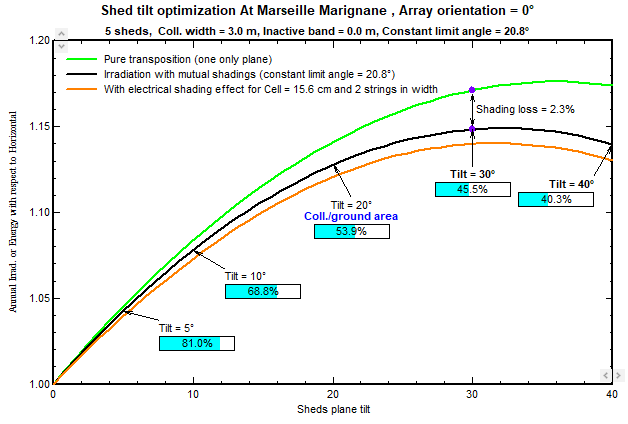Sheds tilt optimization tool
This tool is available when using the Unlimited sheds after clicking on the Show Optimization button. It shows the annual yield of a sheds system function of the sheds tilt. The limit angle is kept constant by degrading the GCR when the tilt increases. The y-axis represents the irradiation gain compared to an horizontal plane, over a full year. The computation is based on the project site and weather data, including the diffuse and albedo components.
The green curve represents the result of the transposition on the tilted plane. The black curve is the irradiation after the linear shading losses. You can observe that the shading losses increase with the tilt. The orange line represents the electrical shading loss, resulting of the shading electrical mismatch.
The blue rectangles represent the GCR (ratio between the collector and ground area).
From this graph, we can draw several conclusions:
- the optimum tilt (maximum yield) is around 36° for the transposition, but reduced to about 31° for the real yield.
- Shading losses are significantly increasing with the tilt.
- the GCR strongly decreases with higher tilts. At 30° of tilt, you can install less than half the available ground area of collectors to keep the same limit angle.
PVsyst Advice: choose a low tilt
PVsyst advices to put the collectors as horizontal as it is reasonable for the cleaning by the rain. For example, with collectors at 5° instead of 30°, you will be able to install almost twice the PV power on a given area. This way you will loose about 9% of efficiency, but gain much more in terms of final energy.
Another consequence is to lower the yield dependency on the sheds azimuth. You can visualize it on the orientation optimization tool. It makes it easier to install the collectors according to the building orientation. When the building azimuth is not south, installing sheds with high tilt will either result in high azimuth losses or be architecturally less acceptable. Last but not least, the supports are simpler (cheaper) and lighter as you lower the need for concrete ballasts to resist the wind,
However with low tilts, frameless laminates should be used in order to avoid dirt and mosses accumulations on the bottom frame.
NB: The limit angle should be limited to 18° up to about 22°. Higher GCR will produce higher mutual shadings, especially due to electrical mismatch.
